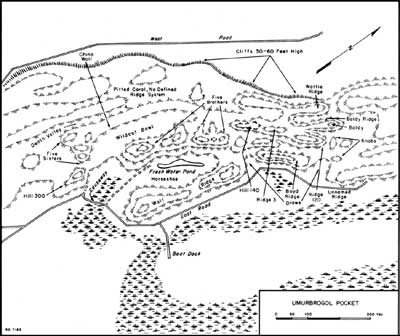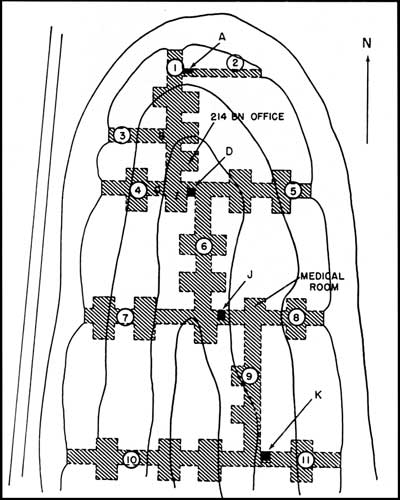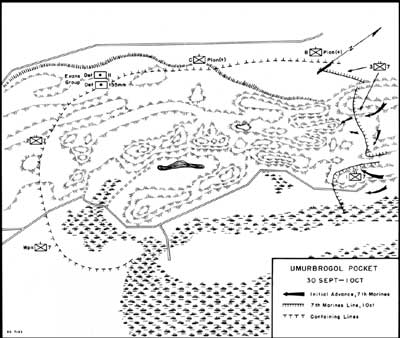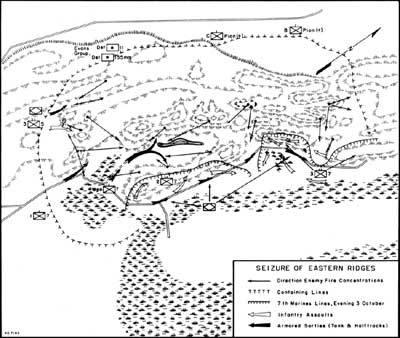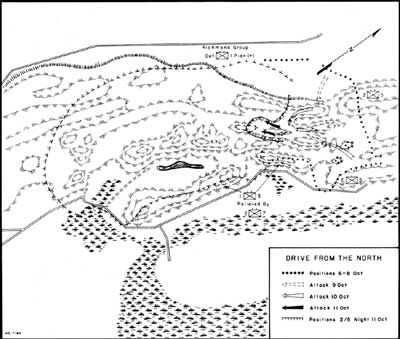| Marines in World War II Commemorative Series |
|
BLOODY BEACHES: The Marines at Peleliu by Brigadier General Gordon D. Gayle, USMC (Ret) The Umurbrogol Pocket: Peleliu's Character Distilled In a very real sense, the Umurbrogol Pocket typified the worst features of the post D-Day campaign for Peleliu. It provided the scene of some of Peleliu's worst and most costly fighting, and of some of the campaign's best and worst tactical judgments. Its terrain was the most difficult and challenging on the island. Prelanding planning did not perceive the Pocket for what it was, a complex cave and ridge fortress suitable to a fanatic and suicidal defense. Plans for the seizure of the area treated the Pocket's complex terrain as oversimplified, time-phased linear objectives to be seized concurrently with the flat terrain abutting it to the east and west. The southern slopes (generally called Bloody Nose) dominated the landing beaches and airfield, over which the Pocket had to be approached. After those heights were conquered by the heroic and costly assaults of Puller's 1st Marines (with Berger's 2/7 attached), and after the division had set in artillery which was controlled by aerial observers overhead, the situation changed radically. The Pocket's defenders there after retained only the capability to harass and delay the Americans, to annoy them with intermittent attacks by fire and with night-time raids. But after D plus 4, Umurbrogol's defenders could no longer seriously threaten the division's mission.
Nevertheless, after the critical enemy observation sites were seized, General Rupertus kept urging "momentum," as though the seizure of the Pocket were as urgent as had been seizure of the commanding heights guarding it from the south. The stubborn character of the terrain, and its determined defenders, became entwined with the determined character of the general commanding the 1st Marine Division. This admixture was sorted out only by time and by the reluctant intercession of General Geiger. Most of the offensive effort into the Pocket between 21 and 29 September was directed from south to north, into the mouths or up onto the ridges of the twin box canyons which defined the Pocket. Infantry, supported by tanks, air, and flame-throwing LVTs could penetrate the low ground, but generally then found themselves surrounded on three sides. Japanese positions inside the ridges of the canyons, hidden from observation and protected in their caves, were quite capable of making the "captured" low ground untenable. Other attacks, aimed at seizing the heights of the eastern ridges, while initially successful, in that small infantry units could scramble up onto the bare ridge tops, thereafter came under fire from facing parallel ridges and caves. They were subject to strong night counterattacks from Japanese who left their caves under cover of darkness. During 20 September, D plus 5, the 7th Marines had relieved the 1st Marines along the south and south west fronts of the Pocket, and on the 21st the 3d and 1st Battalions resumed the attack into the Pocket, from southwest and south. These attacks achieved limited initial successes behind heavy fire support and smoke, but succeeded only in advancing to positions which grew un tenable after the supporting fire and smoke was lifted. Assault troops had to be withdrawn under renewed fire support to approximately their jump off positions. There was little to show for the day's valiant efforts.
Attacks the next day (22 September) against the west shoulder of the Pocket, from the West Road, up the western box canyon (Wildcat Bowl) and toward Higashiyama (Hill 140), all liberally supported with firepower, again produced early advances, most of which had to be surrendered at day's end, as all three attacking groups came under increasing fire from the Japanese hidden in mutually supporting cave positions. The 7th Marines had, unbeknown to it, reached within about 100 yards of Colonel Nakagawa's final command cave position. However, many supporting ridges, and hilltops, would have to be reduced before a direct attack upon that cave could have any hope of success. The fight for Umurbrogol Pocket had devolved into a siege situation, to be reduced only by siege tactics. But the 1st Marine Division's commander continued to cling to his belief that there would be a "break-thru" against the enemy's opposition. He insisted that continued battalion and regimental assaults would bring victory "very shortly." When the 321st's probes eastward near the northern end of the Pocket brought them within grasp of sealing off that Pocket from the north, they deployed two battalions (2d and 3d) facing eastward to complete the encirclement.
This attack against Hill B, the stopper at the northern end of the Pocket absorbed the 321st Infantry's full attention through 26 September, as the 5th Marines was fighting in northern Peleliu. The 7th Marines continued pressuring the Pocket from the south, and guarding it on the west. With the 321st victory on the 26th, that unit's mission was expanded to press into the Pocket from the north. This it did, while simultaneously clearing out the sporadically defended Kamilianlul Ridge to its north. Its attack south from Hill B and adjacent ridges made very limited progress, but permitted some consolidation of the American hold along the north side of the Pocket, now 400 yards wide in that zone. On 29 September, the 7th Marines was ordered to relieve the Army unit in that northern sector. To relieve 2/7 and 3/7 of their now largely static guard positions along the west and southwest sectors of the Pocket, the division stripped hundreds of non-infantry from combat support units (artillery, engineer, pioneer), and formed them into two composite "infantillery" units. Under 11th Marines' Lieutenant Colonel Richard B. Evans and 5th Marines' Major Harold T. A. Richmond, they were assigned to maintain the static hold in the sectors earlier held by 2/7 and 3/7. They faced the karst plateau between the West Road and the Pocket . The 7th Marines' flexibility restored by this relief, its 1st and 3d Battalions relieved the 321st units on 29 September, along the north edge of the Pocket. Then on the 30th, they pushed south, securing improved control of Boyd Ridge and its southern extension, variously called Hill 100, Pope's Ridge, or Walt Ridge. The latter dominated the East Road, but Japanese defenders remained in caves on the west side. The 7th Marines' partial hold on Pope Ridge gave limited control of East Road, and thereby stabilized the east side of the Pocket. But the U.S. hold over the area needed improvement, On 3 October, reinforced by the attached 3/5 (back from Ngesebus), the 7th Regiment organized a four-battalion attack. The plan called for 1/7 and 3/7 to attack from the north, against Boyd Ridge and the smaller ridges to its west, while 2/7 would attack Pope (Walt) Ridge from the south. The attached 3/5 was ordered to make a diversionary attack from the south into the Horseshoe canyon and its guardian Five Sisters on its west. This regimental attack against the Pocket committed four infantry "battalions," all now closer to company than battalion strength, against the heights near the southern end of the Pocket (Five Sisters), and the ridges at the eastern shoulder of the Pocket (Pope and Boyd Ridges). After heavy casualties, the attack succeeded, but the Five Sisters (four of which 3/5 scaled) were untenable, and had to be abandoned after their seizure. The next day, 4 October, the 7th Marines with 3/5 still attached made one more general attack — in the south, again to seize, then give up, positions on the Five Sisters; in the north, to try to advance and consolidate the positions there earlier seized.
In that 4 October action, the 3d Battalion, 7th Marines' push led to an unexpectedly rapid advance which it pressed to get up onto Hill 120. It was hoped that this would provide a good jump-off for the next day's operation against the next ridge to the west. However, Hill 120, as with so many others in the Umurbrogol, was then under enemy crossfire which made it completely untenable. The attacking company was with drawn with heavy casualties. Among these casualties was Captain James V. "Jamo" Shanley, commanding Company L. His company was attacking Ridge/Hill 120 when several of his men fell, wounded. Shanley dashed forward under heavy fire, rescued two of the men and brought them to safety behind a tank. He then rushed back to help a third, when a mortar round landed immediately behind him, mortally wounding him. His executive officer, Lieutenant Harold J. Collins ran out to rescue him, only to fall by his side instantly killed by a Japanese anti tank round. For his heroism Captain Shanley was awarded a Gold Star (second) for the Navy Cross he had earned at Cape Gloucester, New Britain. There, his company was in the lead in seizing Hill 660, a key terrain feature in the Borgen Bay area. The 7th Marines had now been in the terrible Umurbrogol struggle for two weeks. General Rupertus decided to relieve it, a course General Geiger also suggested. Still determined to se cure the Pocket with Marines, General Rupertus turned to his only remaining Marine regiment, the 5th. Colonel Harris brought two firm concepts to this final effort for his 5th Marines. First, the attack would be from the north, an approach which offered the greatest opportunity to chip off one terrain compartment or one ridge at a time. His 1st Battalion positions along the east side of the Pocket would be held statically, perhaps incrementally adjusted or improved. No attacks would be launched from the south, where the 3d Battalion was positioned in reserve. Colonel Harris' aerial reconnaissance during the first week on Peleliu had convinced him that siege tactics would be required to clear the multitude of mutually defended positions within Umurbrogol. As he had earlier expressed himself in the presence of the corps and division commanders visiting his regimental CP. Harris continued with his policy to "be lavish with ammunition and stingy with . . . men's lives." He was in a strong command position to prepare support thoroughly before ordering advances. The 2d Battalion, 5th Marines, relieved 3d Battalion, 7th Marines in position on 5 October, but did nothing but reconnoiter positions where heavier firepower could come into play. Engineer dozers were brought up to prepare paths into the north ends of the box canyons, along which LVT flame throwers and tanks could later operate. A light artillery battery was emplaced along the West Road to fire point-blank into the west facing cliffs at the north end of the Pocket, as were weapons carriers and tanks later. Troublesome sections of certain cliffs were literally demolished by direct fire, and the rubble dozed into a ramp for tanks to climb toward better firing positions. Light mortars were used extensively to strip vegetation from areas in which firing caves were suspected, and planes loaded with napalm-filled belly tanks were used to bomb suspected targets just south of the key Hill 140, which 2/5 had selected as its key objective.
As 2/5 picked off successive firing positions in the north, 3/5 on 7 October sent a tank sortie into the Horseshoe. This time, the mission was not to seize and hold, but to destroy by fire all identifiable targets on the faces of the Five Sisters, and on the western (lower) face of Hill 100 (Pope Ridge). When all ammunition was expended, the tanks withdrew to rearm then returned, accompanied by LVT flame-throwing tanks and guarded by small infantry fire-teams. Considerably more destruction was effected, a large number of Japanese were killed in caves, and many of the Japanese heavy weapons in those caves were silenced. Previous to this time, some single artillery pieces firing from within the Horseshoe had occasionally harassed the airfield. No such nuisance attacks occurred after the 7 October tank sorties.
For the next six days, the 5th Marines headquarters afforded all available support to small, incremental advances by 2/5 from the north. Light mortars were repeatedly used to clear all vegetation from small objectives and routes of advance. Both tanks and artillery were used at point-blank ranges to fire into all suspected caves or rough coral areas. Aerial bombardment with napalm was used to clear vegetation and, hopefully, drive some defenders further back into their caves. All advances were very limited, aimed simply at seizing new firing positions. Advances were made by squads or small platoons. The last position seized, Hill 140, just north of the Five Brothers, afforded a firing site to which a 75mm pack howitzer was wrestled in disassembled mode, reassembled, sand bagged, and then effectively fired from its then-commanding position. It could fire into the mouth of a very large cave at the base of the next ridge, from which serious fire had been received for days. Sandbagging this piece into position posed special problems, since the only available loose sand or dirt had to be carried from the beach, or occasional debris slides. Nevertheless, the use of sandbags in forward infantry positions began to be used in creasingly, and the technique was later improved and widely used when 81st Infantry Division soldiers took over further reduction of the Pocket.
By this mode of careful advance, a number of small knobs and ridges at the head of the two murderous box canyons were seized. Direct fire could be laid into the west face of Walt and Boyd Ridges, whose tops were occupied by 1/5, but those cave-filled western slopes were protected by other caves on the opposite, parallel ridge known as Five Brothers. A week of such siege-like activity pushed the northern boundary of the Pocket another 500 yards south. On 12 October, the 3d Battalion, 5th Marines was called in to relieve 2d Battalion, 5th Marines. The relief was seriously marred, primarily because the forward positions being relieved were so close to the opposing enemy. The incoming troops, including a company commander, were picked off by snipers during this exchange, and a small group of enemy reoccupied a position earlier subdued by frequent interdiction fires. Despite these losses and interruptions, the relief was completed on schedule, and on 13 October, 3/5 continued the slow and deliberate wedging forward. Directly south of Hill 140, there seemed no feasible axis for advance, so 3/5's axis was shifted southwest, approximately paralleling the West Road, and into the coral badlands in front of the containing lines manned by the composite groups guarding West Road. While the composite groups held in place, 3/5 operated across their front, north to south. By this means the coral badlands were cleared out for an average (east-west) depth of 75-150 yards, along some 500 yards of the north-south front. This terrain, earlier judged unsuitable for any but the costliest and most difficult advance, was now traversed with the aid of preparatory fire-scouring by napalm bombs. Major "Cowboy" Stout's VMF-114 pilots' bombs fell breathtakingly close to both the advancing 3/5 front and to the stationary composite units holding just east of West Road. A similar effort was then launched from the south by what was left of Lieutenant Colonel John Gormley's 1/7. Together, these two advances seized and emptied about one-half of the depth of the coral badlands, between West road and the China Wall. This clearing action allowed the composite "infantillery" unit to advance its lines eastward and then hold, as far as the infantry had cleared, toward the back of China Wall. Overall, the actions of the 5th and 7th Marines in October had reduced the Pocket to an oval some 800 yards, north to south, and 400-500 yards, east to west. According to Colonel Nakagawa's contemporaneous radio report back to Koror, he still had some 700 defenders within the Pocket, of which only 80 percent were effective. In early October, some wag had suggested that the Pocket situation be clarified by enclosing it with barbed wire and designating it as a prisoner of war enclosure. Spoken in bitter jest, the concept did recognize that the Pocket no longer counted in the strategic balance, nor in completing the effective seizure of Peleliu.
But it still weighed significantly in the mind of Major General Rupertus, who wanted to subdue the Pocket before turning over to Major General Mueller the 81st Division's previously specified mopping-up task. In point of fact, Rupertus' successful seizure of Ngesebus and northern Peleliu had terminated the enemy's capability to reinforce the now-isolated Japanese on Peleliu. Creation of that tactical situation had effectively secured Peleliu. Without pressing for a declaration that Peleliu had been effectively secured, which would have formalized the completion of the 1st Marine Division's mission, General Geiger had for some days suggested that in continuing his attacks into the Pocket, Rupertus relieve first the 5th, then the 7th Marines with his largest and freshest infantry regiment, the 321st RCT, still attached to 1st Marine Division. To all such suggestions, General Rupertus replied that his Marines would "very shortly" subdue the Pocket. Two events now overtook General Rupertus' confidence. First, the 81st Division was made whole by the return of its 323d RCT, fresh from its critically important seizure of Ulithi. Second, the perception that Peleliu was effectively secured was validated by a message which so stated from Admiral Chester W. Nimitz, Commander in Chief, Pacific Fleet/Commander in Chief, Pacific Ocean Areas. Major General Geiger was directed to turn over command to Major General Mueller, whose 81st Division was now directed to relieve the 1st Marine Division, to mop up, and to garrison Peleliu, as long planned. Rear Admiral George E. Fort, Rear Admiral Theodore S. Wilkinson's successor as commander of operations in the Palaus, was directed to turn over that responsibility to Vice Admiral John H. Hoover, a sub-area commander. When relieved by the 81st Division, the 1st Marine Division would embark for return to Pavuvu.
During the movement and turn over, tactical operations ashore necessarily remained under 1st Marine Division control until the 81st Division could move its command post from Angaur. General Mueller established his CP near Peleliu's Purple Beach on 20 October. The Wildcat Division thereupon acquired "custody" of the Pocket, and responsibility for final reduction of its determined, able, battered defenders. Meanwhile, the relief of the 5th Marines by the 321st RCT took place on 15 and 16 October. While that relief was in progress, Lieutenant Colonel Gormley's 1/7 was still engaged in the earlier-described coral badlands action, to make possible the eastward movement of the containing lines protecting West Road. The relief of 1/7 was accordingly delayed until the next day. On 17 October, a full-strength Company B, 1/323, newly arrived from Ulithi, relieved Gormley's surviving battalion, approximately man for man.
|
